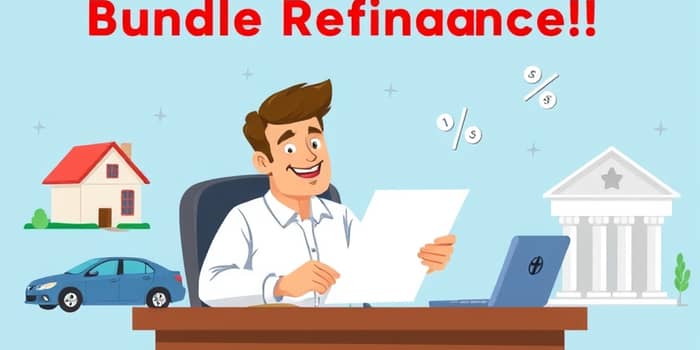
Unlock the power of comprehensive approach to debt consolidation by combining multiple loans into one streamlined arrangement. This strategy can help you significantly reduce your monthly payments and save thousands over the life of your loans.
Bundle refinancing involves merging various financial products—such as mortgages, home equity lines of credit, and auto loans—into a single refinance with one lender. This maximize your leverage for lower fees approach allows borrowers to negotiate terms on a broader portfolio of business.
In contrast, pure rate negotiation focuses solely on reducing the interest rate of an existing loan, leaving the underlying terms and products intact. While rate negotiation can be quicker and cost-effective, it doesn’t offer the same flexibility as a full refinance.
By bundling, you gain increased bargaining power and the potential for:
Presenting a larger ‘‘bundle’’ of loans often incentivizes lenders to offer substantial interest savings over loan term in order to retain or win your business.
Current market trends show that the gap between posted and negotiated mortgage rates can exceed 1%. For instance, a five-year fixed mortgage advertised at 5.5% may be negotiated down to 4.5%. On a $375,000 mortgage, that 1% reduction saves approximately $9,400 over five years.
Consider another example: reducing your rate by 0.5% on a $400,000 mortgage can save roughly $5,000 in interest over four years. Meanwhile, 24% of home sellers offered concessions in 2024, such as covering closing costs or buydowns, compared to 33% in 2023—demonstrating lenders’ and sellers’ willingness to negotiate.
Typical closing costs range between 2–5% of the loan amount. Negotiating an appraisal fee waiver or origination fee reduction can cut expenses by several hundred dollars.
Adopt these proven tactics to enhance your negotiation power:
Timing plays a crucial role: lenders under pressure to meet quotas are often more willing to sweeten offers with lower rates or fee waivers.
Prepare meticulously to ensure a smooth refinancing or negotiation process:
A well-organized approach signals to lenders that you are a serious, low-risk candidate.
Choosing between bundling with refinancing and negotiating your existing rate depends on your goals:
If you seek additional features—such as home equity access, debt consolidation, or special loan options—or if you want to adjust your loan term, a full refinance is the better choice. Conversely, if you are satisfied with your current lender and mainly want a lower rate with minimal hassle, pure rate negotiation may suffice.
Always calculate your break-even point by comparing projected savings against upfront costs. This will reveal whether the refinance fees justify the potential interest reductions.
Meet Sarah, a homeowner who combined her $250,000 mortgage and $30,000 HELOC into one refinance at 4.25%, down from an average of 5.75%. Her streamline your financial commitments with ease strategy saved $12,000 in interest over five years and eliminated one monthly payment.
Conversely, Mark attempted a rate negotiation on his existing mortgage without gathering competing quotes. He accepted a 4.75% offer—only marginally below his posted rate—and missed out on a 4.2% deal available through a rival lender. His key mistake was failing to leverage alternative offers for better terms.
Bundle refinancing paired with strategic rate negotiation offers a potent way to streamline your financial commitments with ease while unlocking significant savings. By following the practical steps and expert tactics outlined here, you can negotiate from a position of strength and achieve substantial interest savings over loan term. Take control of your debt today by researching lenders, preparing documentation, and confidently pursuing the best possible deal.
References













